Künstlerische Leitung: Mareen Alburg Duncker.
Förderschule „Astrid Lindgren“, Halle (Saale)
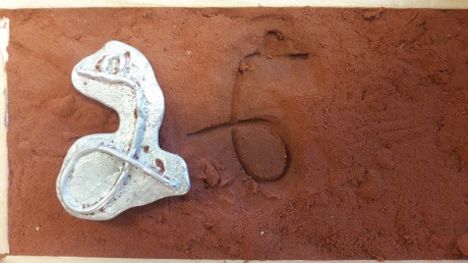
This year, Mareen Alburg Duncker introduced the children of the “Astrid Lindgren” special school to the technique of sand casting. At the beginning, the mold for the sand casting was planned. For this purpose, the pupils built wooden boxes under supervision, which were filled with cast sand. Initially, small found natural materials such as branches, stones, shells and acorn caps were used as casting patterns. Later, letters were also bent from aluminum wire and wax models were created from hard wax using tools. These models were pressed halfway into the solid sand. Tin was then heated until the melting point was reached and then poured into the molds. After cooling, the casting blank could be removed and cleaned. A belt served as a suspension for the castings. After an introduction, the students cast their molds independently. They clearly enjoyed learning the technique and gaining the confidence to cast on their own. They drilled, sanded and polished with enormous patience and creativity. The result is small, unique pieces that are sure to be worn for a long time.
Artistic director: Christiane Budig.
Elementary school “Am Mühlberg”, Landsberg Hohenthurm
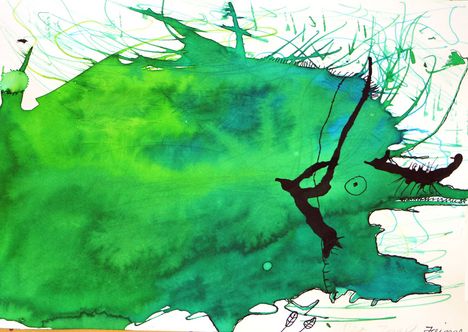
Inspired by Luther’s inkblot on Wartburg Castle in Luther Year 2017, the children in Year 4 at the “Am Mühlberg” elementary school in Hohenthurm worked with associative images. They made their own random pictures using ink blowing or thread graphics (materials: different sizes of drawing card, black ink, colored ink, drawing pens, toothpicks, drinking tubes). They expanded them with their imaginary abilities, fired their imagination and made them visible in the picture. Color knowledge in the area of color mixtures was deepened through experimentation, and design issues were addressed through the students’ own actions. The starting point for the designs was their own pictorial imagination; no theme was specified. The pupils’ own and individual skills were awakened through creative activities. This shared positive experimentation experience in the classroom can stimulate curiosity and openness to new things.
Künstlerische Leitung: Carola Helbing-Erben.
Grundschule im Schloss Ostrau, Petersberg
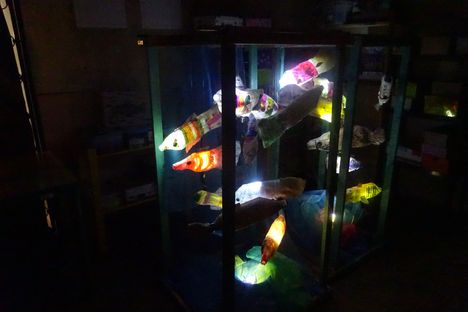
Inspiriert von einem Märchen über einen leuchtenden Fisch und von Fotos und Videos von Lichtkunst-Objekten, konnten die Kinder der 4. Klasse aus der Grundschule „Schloß Ostrau“ selbst Lichtobjekte gestalten, in denen Fische das Gestaltungsziel waren. Entstanden sind zwei Arbeiten, ein Objekt, das von innen beleuchtet wird und ein Lichtkasten, indem das Licht hinter der Arbeit ausstrahlt. Im ersten Objekt war die Arbeit eine freie Gestaltung, in der Form und Musterung nicht zwingend an eine Naturvorgabe gebunden waren. Diese erste Arbeit bot ein kollektives Spiel aller Fische in unterschiedlichen Formen und Farben im Aquarium. In der zweiten Arbeit stand das Naturstudium von realen Fischen im Vordergrund. Für die Transparenz der Objekte wurden transparente Papiere gewählt. Im abgedunkelten Raum erlebten die Kinder die Wirkung der Lichtobjekte und waren begeistert.
Künstlerische Leitung: Claudia Klinkert.
Saaleschule for (H)all, Halle (Saale)

At the Saaleschule in Halle Trotha, the 7th grade learned about “Paperclay”, a clay-paper mixture that makes it possible to work with clay in a completely new way. After an introduction, the aim was to produce a thin slab of clay with paper-like properties and use it to build objects on the theme of winged creatures. First, a paper-clay paste was made, which was spread on cloth-covered plates and allowed to dry. Sketches were then created on the subject of winged creatures. Before the paperclay board was used, models were built from paper and cardboard as a preliminary exercise. The initial uncertainty about building with surfaces was quickly replaced by the construction of more complex structures. The Paperclay plate now brought new possibilities and difficulties. As a result, the previous models were rarely adopted, but rather modified or even discarded. The slabs were also instinctively kneaded together to form lumps of clay, creating sculptural works. At the end, the objects could be assembled with attached parts and painted with engobe. Some smaller objects were created by working freely and playfully with the slab remnants. The pupils were inspired by the new material they had learned and encouraged to create a variety of artistic arrangements.
Künstlerische Leitung: Claudia Berg.
“Levana-Schule Eisleben”, special school for the mentally handicapped, Lutherstadt Eisleben
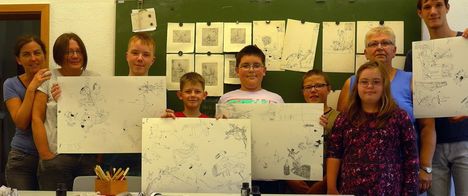
Claudia Berg supervised the “St. George” art project at the “Levana School Eisleben” for two days, including an overnight stay. In keeping with the Luther Year, the theme was St. George, who played an important role for Martin Luther. Drawings were made together using old engravings, which were then transferred to copper plates and printed. Working together as a group, drawings were created on one sheet as a joint result. The production of the etchings involved the transfer of a drawing into a printing technique, combined with learning the printing process.
Artistic direction: Katrin Röder.
Gotthold Ephraim Lessing” elementary school, Halle (Saale)
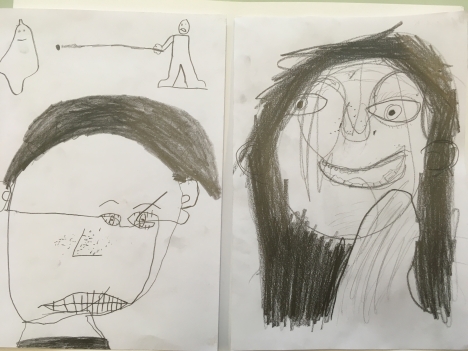
In this project, supervised by Katrin Röder, the pupils of the “Gotthold Ephraim Lessing” elementary school were first asked to take part in an experiment. The task was to draw the person sitting next to you with a pencil. The difficulty: This should be done without putting the pen down and without looking at the page. This was very unfamiliar for the students, but after some initial hesitation, lively structures were found. In a second step, corrections and additions could also be made. Very expressive and unusual drawings were created.
Artistic direction: Annegrete Riebesel.
Gotthold Ephraim Lessing” elementary school, Braunsbedra
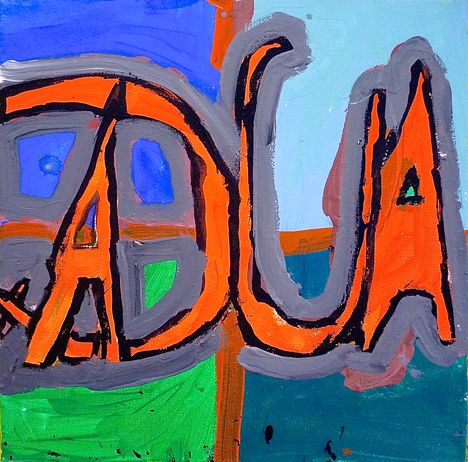
The art project was part of the lessons offered by the “Gotthold Ephraim Lessing” elementary school in Braunsbedra, which took place once a week during school lessons. At the beginning of the school year, the children were able to choose from a range of offers. The offer for the art project was called “Graffiti” and was supervised by Annegrete Riebesel. A total of 15 children from the 3. and 4th grade participated. The aim was to create a design for the unadorned walls in the English room that makes reference to language learning. The children painted with acrylic paints on smaller canvas formats. English vocabulary for colors was discussed. The square canvases are to be hung as a frieze or as one continuous surface in the English room.
Artistic director: Karoline Peisker. Maria Montessori Primary School, Halle (Saale)
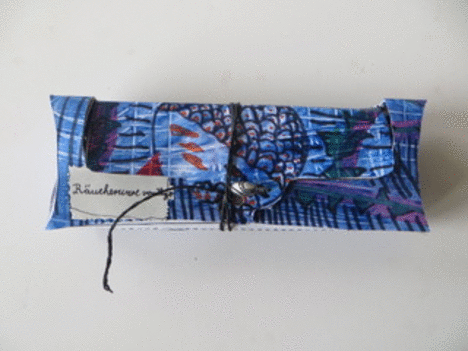
Under the direction of Karoline Peisker, the pupils of the Maria Montessori Primary School in Halle created precious paste paper based on oriental patterns. They turned these into unique packaging for home-made incense sticks. Disposable jars were recycled into oriental-style incense holders. Food art elements were also part of the artistic offering. Baking wafers were decorated with icing, sugar sticks and sugar pearls according to oriental patterns. The sweet ceramics, created with loving artistic dedication, could be enjoyed after the photos were taken. The sense for proportions, balanced forms and color combinations was trained. Inspired by the patterns of oriental architecture, its gardens and the splendid textile art, many unique, consumer goods were created, just as they might be offered at a Persian bazaar.
Artistic director: Karoline Peisker.
European and all-day school “August Bebel”, Blankenburg

Together with her colleague Josefine Cyranka, Karoline Peisker offered workshops for school classes at Michaelstein Monastery in Blankenburg. In terms of content, both worked on the theme of fish, in keeping with Michaelstein Monastery and the upcoming Lent. They talked to the pupils about our Christian way of life, about the associated eating habits of fish dishes (for example on Holy Friday), about Carnival and Lent and about the origins of the Christian symbolism of fish. In her art printing workshop, Karoline Peisker taught the students a special intaglio printing technique – tetrapack etching, in which the silver-colored coatings of milk cartons are refined into filigree printing blocks with the help of an etching needle and cutter knife. The prints were photographed, resulting in a small limited edition of postcards.
Künstlerische Leitung: Renée Reichenbach.
“Levana-Schule Eisleben”, special school for the mentally handicapped, Lutherstadt Eisleben
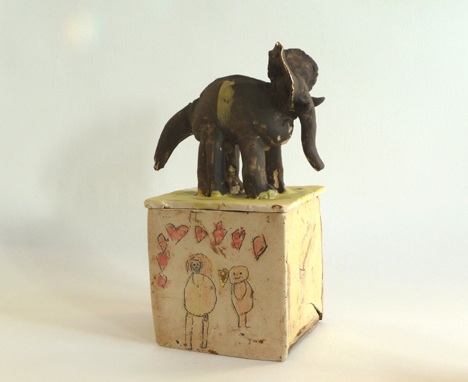
Children need containers for their treasures. Under the direction of Renée Reichenbach, the pupils of the “Levana School Eisleben” shaped ceramic lidded vessels. Inspired by the children’s favorite animal, boxes were created that bear this animal as a stubbornly formulated small sculpture on their lid, containers with a figurative lid handle or a base for a sculpture. The ceramic material with different colored clays and various engobes offered the students the opportunity to play around with the task set and their own ideas. With a lot of energy and perseverance, small works of art were created with their very own effect and charisma.
Künstlerische Leitung: Dietmar Sauer.
Norbertusgymnasium, Magdeburg

Dietmar Sauer instructed a sculptural design made of wood at the Norbertusgymnasium in Magdeburg. With creative imagination, the pupils extended their wooden scaffolding with other materials, such as their own collected finds (e.g. driftwood, small metal finds, plastic, bones, etc.). “Artists put prefabricated objects with different levels of reference into a new context and use them as material for their compositions. Putting these parts together can enable a new perception, as the original meanings of the objects are known, but are now presented in a completely new context”. In accordance with this definition, small wooden objects were rearranged by the pupils and placed in an artistic context, whereby the symbiosis with other materials became a component of sculpture and object art. The pupils initially explored the topic individually or in small groups by drawing and developed an idea concept. It was observed that the class developed an identification with their work. They began to see their ideas as group work and to implement their concept together.
Künstlerische Leitung: Grit Wendelberger.
Kastanienschule Aschersleben, special school for the mentally handicapped
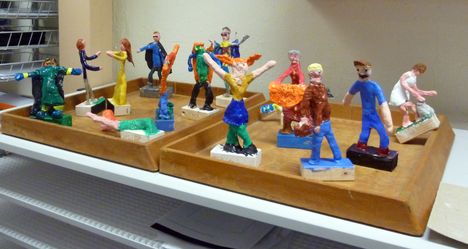
Under the artistic direction of Grit Wendelberger, a team of teachers at the Kastanienschule Aschersleben developed the five-day workshop “My favorite animal” for around 30 pupils aged 6 to 10. They dealt with beloved animals and their questions about them in a playful and painterly way. A quiz was followed by painting games such as “Two strokes make an animal”, “A fantasy animal is created together” and “Painting animals with music”. The children painted and collaged their favorite animals individually or in groups, supporting each other in the process. The three groups built a water, land and air zoo with all the animals they had created. Then the groups visited each other and experienced a magical performance in the water zoo with “water music”, soap bubbles as the breath of the fish and colored cloths as waves, which impressed everyone. During this art project week, the children painted on cardboard with school tempera bottle paints, finger paints, wax crayons and colored pencils. They doodled, practiced body prints, cutting, dripping, tearing, gluing, rhythm and teamwork. There was something for all the senses and they also learned a lot about the lives of animals, whether at the zoo or at home.
Artistic director: Beate Gödecke.
Hans Christian Andersen” Primary School Halle (Saale)

Under the title “Me and my world”, 18 children from Year 4 created a ceramic tile in low relief. After a theoretical introduction to the topic of relief, the children then clarified what is important to them in their everyday lives. They often mentioned their pet, their family, but also their Playstation or soccer club. After the children had recorded their results in a design on paper, this was implemented on a prepared tile made of clay. Using thin pieces of wood, they carved the lines of the relief into the tiles. After firing, they were colored with engobes and glazes. The children were very proud of their tiles. These now contribute to a more attractive design of the school building. The project enabled the children to experience themselves as active co-creators of their living environment.
Artistic direction: Klaus-D. and Pauline Ullrich.
Secondary school “Campus Technicus”, Bernburg
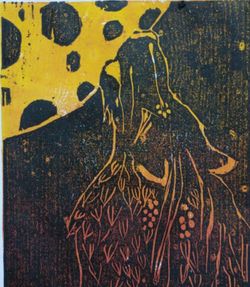
Fifteen pupils from grades 7-10 took part in Klaus-Dieter and Pauline Ullrich’s three-day woodcut project at the “Campus Technicus” secondary school in Bernburg. Examples of images and the textile reprint of a tapestry for the panel painting served as inspiration. After initial sketches, in which the subject matter was also clarified, the first concrete drafts emerged from the initial attempts. These were then transferred to the wooden panel and it was time for the laborious cutting with the wood carving knives. After cutting the wood, the color adventure began. Different colors were used for underprinting. It was interesting to see how the elaborate technique streamlined shapes and developed a sense of form. Likewise, a different understanding of color soon emerged, as color in printing changed the expression of what was printed. There was great enthusiasm for printing. For example, the elaborate iris print (as a colored underprint) was discovered by the young people themselves and used again and again.
Artistic director: Rosemarie Ullrich. Nördliches Salzatal” elementary school, Beesenstedt
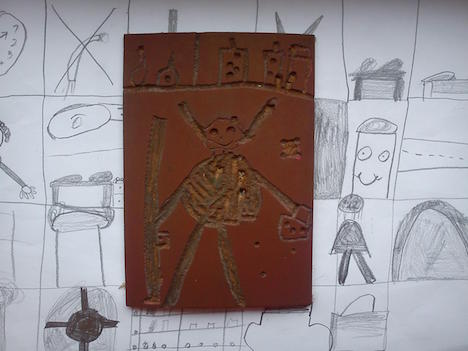
Eighteen pupils from Year 3 at the “Nördliches Salzatal” elementary school in Beesenstedt are working with Rosemarie Ullrich on the classic children’s book “Sophie and the Giant” by Roald Dahl. In addition to jars with collected dreams, dream catching nets and glucose water, the focus soon shifted to representation and display options. In the end, the results were drawings and prints (in addition to the intangible benefits, such as the children’s dreams and mental work). In an intensive examination of the linocut technique, charming cut printing plates were created, which have a special, child-like expressiveness in the graphic realization by the children’s hands.
Künstlerische Leitung: Josefine Cyranka.
European and all-day school “August Bebel”, Blankenburg
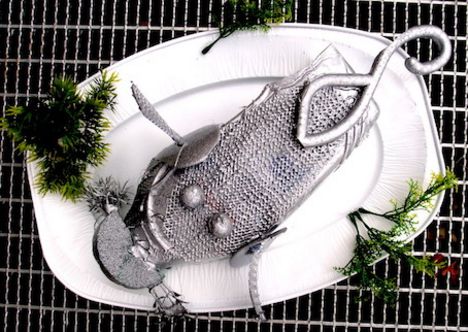
Michaelstein Monastery, with a trout farm on the grounds, was the perfect place to talk to the young people about fasting rules, Lent, Shrove Tuesday and the longing for less instead of more. In full concentration, they drew edible fish with all the details, using ink and paint. Then it was off to the third dimension. They made fish bodies from plastic waste such as bottles or party cutlery, sprayed them with silver paint and arranged them on a platter as a fasting dish. A series of postcards was created from the photos of the work, which were on display in the monastery and at the school.
Künstlerische Leitung: Josefine Cyranka. Regenbogenschule Landsberg, special school for the mentally handicapped
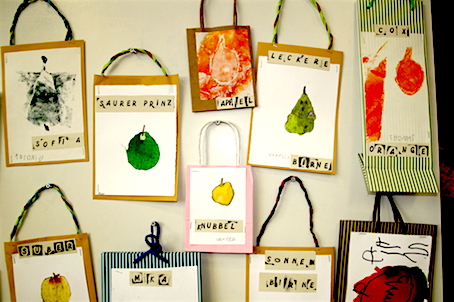
We reached into a fruit basket and smelled the apples and pears. Delicious! Each apple has its own character head, so we portrayed it with fineliner and watercolor. The monotype paint, on the other hand, stank and stuck, but if you scratched the glass plate and applied a cut-out apple stencil like honey, it made a wonderful impression that decorated our paper bags. It already looked like a fruit store! Now it was time for art: entire still lifes were created using the monotype technique and the art celebration included knives, forks and plates made by the designers.
Artistic director: Ilka Leukefeld.
Reinhard Lakomy” special school, Halberstadt
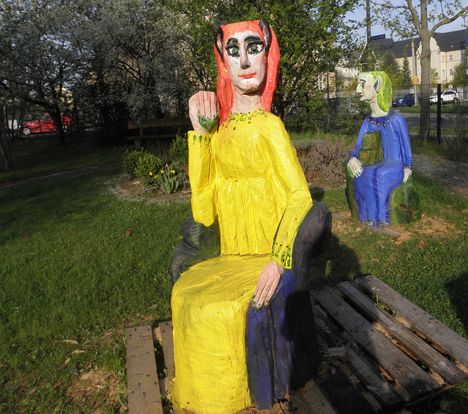
In the green classroom of the “Reinhard Lakomy” special school in Halberstadt, pupils were able to build figures from Lakomy’s children’s musicals out of wood in the form of practical seating furniture. Based on student designs, Kater Bielefeld, Katzenprinzessin Odessa and Waldgeist Moosmutzel were created from three tree trunks, each 1.50 m long and 80 cm in diameter. It was exciting to see how the figures gradually became visible with chainsaws (by the artist Ilka Leukefeld), chisels, hammers, rasps, files, grinders and, of course, a lot of enthusiasm. The incentive for the twenty pupils involved was the many praising comments from passers-by.
Künstlerische Leitung: Marija Falina.
Grundschule Neumarkt, Halle (Saale)
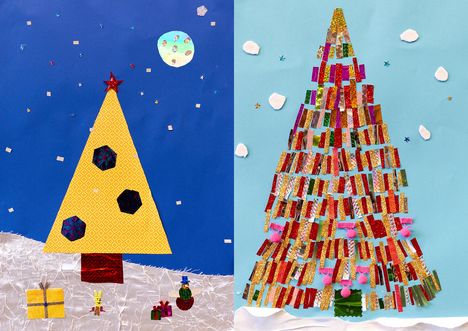
The “Colorful Trees” project led by Marija Falina took place in a 4th grade class at the Neumarkt elementary school in Halle over three days during the pre-Christmas period. This involved inventing and decorating their own “colorful trees”. Miniature drawings and large collages were created. The focus was on creative approaches to form and color as well as discovering variations within a defined framework. Both artistic ingenuity and the varied use of different materials were introduced to the pupils in this way.
Artistic director: Stefan Scholz.
Gotthold Ephraim Lessing” elementary school, Halle (Saale)

The project “I’m looking for a picture” took place in a 4th grade class at the “Gotthold Ephraim Lessing” elementary school in Halle and included the basics of composition and drawing. With small “viewfinders”, which are also used for searching for motifs in photography, we went on a tour of the Paulusviertel together. The resulting impressions and ideas were then translated into graphic drawings with exciting perspectives and views, discussed in the group and evaluated. In this way, the pupils playfully internalized the basics of image composition and image effect.
Artistic director: Margit Jakob.
Rosa Luxemburg” elementary school, Halle (Saale)
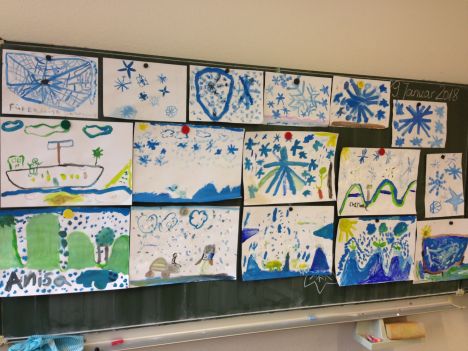
The story “Claude and Wood”, written by the leading artist Margit Jakob herself, which tells the adventures of two little polar bears from Canada, was the starting point for a journey into winter, the north, to the animals and cold colors. Children from Year 2 at the “Rosa Luxemburg” elementary school in Halle traced this time of year in drawings and colorful leaves.
Artistic director: Annegret Frauenlob.
Freie Schule Bildungsmanufaktur, Halle (Saale)
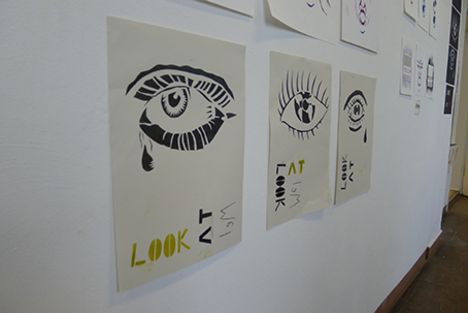
The “Stencils” project days on the technique of stencil graphics enabled the pupils from the 6th and 9th grades of the Bildungsmanufaktur at the Riesenklein Bildungshaus to get to grips with street art. The focus was on finding their own motifs and implementing them in the form of a stencil on various surfaces. The girls learned about stencilling as a means of repeating their own graphics in different variations. They practiced making drawings and working on them in such a way that they corresponded to the principle of the stencil.
Künstlerische Leitung: Silke Trekel.
Salzmünde elementary school, Salzatal
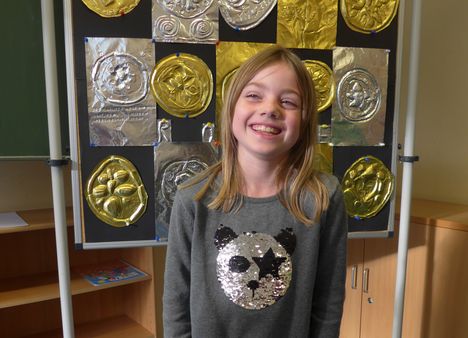
To mark the 500th anniversary of the Reformation, the pupils at Salzmünde elementary school focused on the Luther rose, which Martin Luther created from his family’s coat of arms as a symbol of his religious doctrine, as part of the 2017 school project. In addition to a Luther quiz, which served to test their knowledge in a playful way, the pupils learned the technique of metal spinning in the artistic-practical part and tried out various exercises using a sample plate. Their own designs for the Luther rose on paper were then transferred to aluminum foil.
